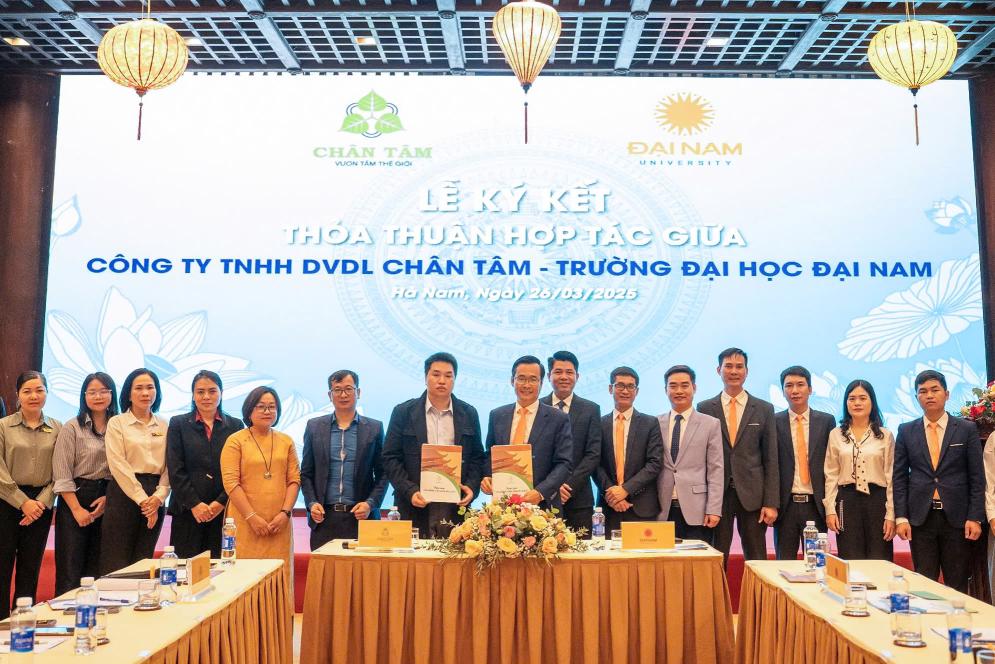Lecturer of DNU Faculty of Medicine shares knowledge on Covid-19 prevention

Dear medical students of Dai Nam University!
Teachers are very touched to know that with the spirit of "Where there is a need, there is a youth", you are ready to join the network of "Companion Doctors" to contribute to quickly suppressing the Covid-19 epidemic in Hanoi. In this article, I would like to share with you some information about the disease and measures to prevent Covid-19, helping you gain more knowledge to complete your assigned tasks well.
After studying microbiology, students have learned that Covid-19 is an acute infectious disease of group A caused by the SARS-CoV-2 virus. This virus frequently mutates to create new strains with the ability to spread faster. By July 2021, Vietnam has recorded 07 strains of the SARS-CoV-2 virus. Particularly in the epidemic from April 27, 2021 to now, our country has recorded 03 variants: Alpha, Delta and Omicron, of which the Delta variant has a transmission capacity 50% higher than the Alpha variant, the Omicron variant has a transmission capacity 4 times stronger than the original SARS-CoV-2 strain and 2 times stronger than the Delta variant.
COVID-19 is transmitted from person to person through the respiratory tract. The incubation period is about 14 days. Most people infected with SARS-CoV-2 virus do not have clinical symptoms. For people with symptoms, the clinical manifestations are very diverse, ranging from mild to severe, such as fever, cough, sore throat, fatigue, body aches, loss or loss of taste and smell; difficulty breathing, possibly severe pneumonia, acute respiratory failure and death, especially in people with underlying medical conditions, people with chronic medical conditions, and the elderly. To date, there is a vaccine to prevent the disease, but there is no specific treatment.
To confirm the diagnosis of covid-19 infection, it is necessary to rely on a positive SARS-CoV-2 test result.
Covid-19 diagnostic testing process:

Measures to prevent covid-19 include:

Do 5k and get vaccinated:

Definition and conditions of home quarantine for F0 and F1
F0
Suspected case
- Being a close contact (F1) and having at least 2 of the following clinical symptoms: fever; cough; sore throat; runny nose, stuffy nose; body aches, fatigue, chills; reduced or lost sense of taste; reduced or lost sense of smell; pain, headache; diarrhea; difficulty breathing; respiratory tract infection.
- Is a person with epidemiological factors (excluding F1) and has at least 2 of the above clinical manifestations.
- Is a person with a positive rapid antigen test result for SARS-CoV-2 virus.
- A person with epidemiological factors (not including F1) is a person who is present on the same means of transport or at the same location, event, workplace, classroom... as a confirmed case (F0) in the transmission period.
- People living in or coming from active epidemic areas.
A confirmed case (F0) is one of the following cases:
- Is a person who tests positive for the Sars-CoV-2 virus using the method of detecting the virus's genetic material (PCR).
- Is a close contact (F1) and has a positive rapid antigen test result for Sars-CoV-2 virus.
- Is a person who has 2 consecutive positive rapid antigen test results (2nd test within 8 hours from the first test result for Sars-CoV-2 virus) and has epidemiological factors (excluding F1).
Rapid antigen testing reagents for the Sars-CoV-2 virus must be on the list licensed by the Ministry of Health. Rapid antigen testing is performed by medical staff or by suspected infected people under the supervision of medical staff in at least one of the following forms: directly or indirectly via remote means.
F1
Close contact (F1) is one of the following cases:
- People who have direct physical contact (shake hands, hug, kiss, direct contact under the skin, body...) with F0 during the transmission period of F0.
- People wearing masks have contact or communication within 2 meters or in the same narrow, closed space for at least 15 minutes with a confirmed case (F0) while in the F0 transmission period.
- People who do not wear masks have close contact or communication within 2 meters or are in the same narrow, closed space with F0 during the F0's transmission period.
- People who directly care for, examine and treat a confirmed case (F0) during the F0's transmission period without using full personal protective equipment (PPE).
According to the Ministry of Health, the transmission period of a confirmed case (F0) is calculated from 2 days before the onset (for confirmed cases without symptoms, the transmission period is calculated from 2 days before the date of sample collection with positive test results) until the test result is negative or the CT value>30 (CT - Cycle Threshold, is a value that appears in RT-PCR tests, the gold standard for detecting the Sars-CoV-2 virus).
Home quarantine criteria
For F0
- Meets 2 clinical criteria
- No symptoms or mild clinical symptoms (no respiratory failure: Spo2 ≥ 96% when breathing air, respiratory rate ≤ 20 breaths/minute).
- Age from 1 to under 50 years old, no underlying disease, not pregnant, not obese. For cases that do not meet these conditions, they can still be considered at home if they have stable underlying disease, ensure 1 full injection or after 14 days from the date of the first Covid-19 vaccine injection.
- Ability to take care of themselves: F0 people can take care of themselves such as: eating, bathing, washing clothes, hygiene...; know how to measure body temperature; can take medicine according to doctor's prescription; can contact medical staff for monitoring, supervision and in case of emergency. In case F0 is a child or a person who cannot take care of himself/herself, he/she needs someone to support and take care of him/her.
- There is no one in the family who is in a risk group (elderly, has underlying disease, obesity, pregnancy...).

For F1
The conditions for F1 to be quarantined at home are to have received 2 doses of Covid-19 vaccine, have a green card on the Electronic Health Book or a Certificate of Full Vaccination, issued by a competent authority; the last dose was given at least 14 days ago and not more than 6 months ago.
People who were F0 and recovered from the disease within 6 months, have a hospital discharge certificate or a certificate of recovery from Covid-19, are also quarantined at home.
All F1s must be tested twice using PCR or rapid antigen testing.
Number of tests
- For F0
Test on the first and 10th day using Realtime RT-PCR method or rapid antigen test 2 times in a row negative (2nd test within 8 hours from the first test result, rapid test licensed by the Ministry of Health).
- For F1
People who have received 2 doses of vaccine should have their Sars-CoV-2 tested by Realtime RT-PCR or rapid antigen test twice (once at the beginning of quarantine,
second time on saturday).
Requirements for facilities and equipment
Housing: There are individual houses or apartments in collective housing areas or apartment buildings. The house has a closed isolation room, separate from the family living area.
In front of the house: The homeowner needs to place a red background, yellow warning sign: "Covid-19 epidemic prevention and control medical isolation location", with a yellow bin with an infectious waste symbol labeled "Waste at risk of containing Sars-CoV-2" to store personal protective equipment discarded by medical staff.
In front of the isolation room: Arrange an isolation table to provide separate meals, drinks and other necessities for the isolated person.
The isolation room should have:
- Yellow bin with lid, opened by foot pedal, yellow lining bag for waste including: masks, towels, tissues, labeled "Waste at risk of containing Sars-CoV-2". Blue bin with lid, opened by foot pedal and lined with blue bag for other household waste.
- Private toilet and bathroom, with full personal hygiene products, hand soap,
clean water, hand sanitizer containing at least 60% alcohol.
- Have personal temperature measuring device.
- Have a washing machine or bucket, basin for people in quarantine to wash their own clothes.
- Includes broom, mop, rag, 2 buckets and disinfectant or general cleaning solution
Usually let the quarantined person clean and disinfect the room themselves. The quarantine room must be cleaned and disinfected daily.
- Do not use central air conditioning, can use separate air conditioning; ensure ventilation
Ventilate, it is best to open windows often.
- Encourage the installation of cameras to monitor people in quarantine.
- Must be fully equipped with personal protective equipment to prevent infection (medical masks, medical gloves, shoes, goggles, pants, shirts) for family members to use when required to have close contact with quarantined people.
- It is strictly forbidden to take the quarantined person's belongings out of the house.
Requirements for disinfection and waste management
Environmental disinfection:
- Clean and disinfect the environment at least twice a day in the following locations: floors, bathroom floors and frequently touched surfaces such as tables, chairs, bed frames, wardrobes, refrigerators, door handles, toilets, sinks, faucets...
- Surfaces, utensils, and objects must be cleaned before disinfection. Caregivers must be instructed and wear masks and gloves when cleaning and disinfecting environmental surfaces.
- Cleaning and disinfecting solution with regular detergent and 70-degree alcohol. Regularly use 70-degree alcohol to wipe surfaces and electrical and electronic devices such as: switches, lights, TV remotes, phones... Before wiping, turn off the power.
Disinfect clothes and belongings of quarantined people:
- Wash the clothes of the quarantined person separately, preferably in the quarantine room.
- Before washing, soak fabric with laundry soap for at least 20 minutes.
- Dry clothes in a private place with lots of sunlight.
Waste management:
- Waste generated from medical isolation rooms at home or places of residence: masks, tissues, and discarded mouth and nose wipes of quarantined people must be put into waste bags, sprayed with 70-degree alcohol to disinfect and tie the bag tightly, and put into a waste container with a bag liner and a tight lid placed in the quarantined person's room.
- During the quarantine period, if the quarantined person shows symptoms of suspected Covid-19 infection, the environment must be disinfected and treated according to instructions to collect all types of waste from the quarantine room of the person infected or suspected of being infected with Covid-19 for transportation and treatment as infectious waste.
- After the quarantine period, if the quarantined person does not show symptoms of suspected Covid-19 or has a negative test result for Sars-CoV-2, collect the waste bag and treat it like regular waste.
Perform
- Every day, people in quarantine must limit leaving their private rooms; limit direct contact with family members, accommodation and other people; self-monitor their health; implement personal hygiene measures, wear masks, and regularly wash hands with soap or other antiseptic solutions.
- The quarantined person must make a daily declaration on the application about their health status and comply with the commitment to quarantine at home. In addition, the quarantined person must notify the assigned commune, ward, or town health officer in charge of monitoring twice in the morning and afternoon about the results of their temperature measurement and their health status.
- Do not leave your home or place of residence without permission; make a commitment to local authorities.
- Must comply with 5K; if there are any unusual signs of health such as: cough, fever, difficulty breathing, sore throat, loss of taste... then immediately notify the medical facility.
Time to end medical isolation
For F0
For asymptomatic or mildly symptomatic Covid-19 patients who are eligible for home isolation and treatment according to regulations, home isolation and treatment will be removed when:
- Quarantine and treatment period of 10 days; negative antigen test results twice for Sars-CoV-2 virus performed by staff or self-performed by the patient under the supervision of medical staff by at least one of the following methods: directly or indirectly via remote means (rapid test licensed by the Ministry of Health).
- The medical station that manages the patient is responsible for confirming the patient's recovery.
- Self-monitor your health for the next 7 days at home, still limit contact with people around you, and seriously follow the 5K message.
For F1
Patients who have received 2 doses of the Covid-19 vaccine are quarantined at home or at their place of residence for 7 days. A rapid antigen test is performed on the 7th day. If the result is negative, the quarantine is ended and self-monitored for the next 7 days, strictly following the 5K message.

Hanoi distributes Covid-19 treatment drugs including 3 bags of medicine as follows:
- Medicine bag A: (including Paracetamol fever reducer, vitamin supplements), these medicine bags with instructions for use are given immediately to patients when they are eligible for home treatment and are issued by the health station.
- Medicine bag B: includes anti-inflammatory Corticoid, anticoagulant drugs, used only in special situations and must be evaluated and prescribed by a doctor for the patient, using a single dose before transferring the patient (used in case the patient shows signs of worsening)
- Drug bag C includes antiviral drugs: Molnupiravir, Favipiravir, these are drugs that have not been licensed by the Ministry of Health for circulation, distributed according to the Ministry of Health's program, and used under control, so to be able to use them, people infected with COVID-19 must be screened, evaluated, and have a commitment to agree to participate in the program. When using antiviral drugs, they must comply with and be closely monitored by medical staff.
Wish you good health and success in your assigned tasks!
MSc., Dr. Ta Thi Thanh Phuong - Lecturer of Faculty of Medicine, Dai Nam University
Register for admission consultation 2025
scholarships and tuition support worth up to 55 billion VND

scholarships and tuition support worth up to 55 billion VND








